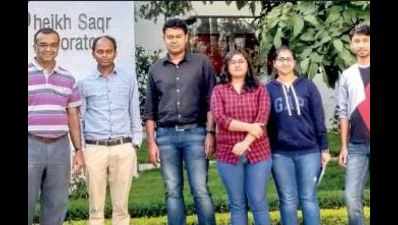- News
- City News
- bengaluru News
- They find way to recover electricity from ‘wasted’ heat
Trending
This story is from January 19, 2019
They find way to recover electricity from ‘wasted’ heat

(L to R) Prof Umesh Waghmare, Kanishka Biswas, Tanmoy Ghosh, Ananya Banik, Raagya Arora and Moinak Dutta
BENGALURU: Nearly 90% of the energy we use comes from burning of fossil fuels and natural gas reserves and at least 65% of this energy gets irreversibly wasted as dissipated heat — an alarming scenario as the global energy crisis looms. Now, imagine a technology that recovers electricity from ‘wasted heat’ generated by burning of fossil fuels, which can then be used to power our homes, vehicles and mobile phones.
In their latest paper, researchers from the Jawaharlal Nehru Centre for Advanced Scientific Research (JNCASR), Jakkur, have claimed a breakthrough that allows this.Their research has been published in the peer-reviewed journal, Energy & Environmental Science, by the Royal Society of Chemistry (RSC).
“We’re confident industry will lap this up. We haven’t yet discussed it as we wanted our findings to be peer reviewed and published. The next step will be to talk to industial units,” said Prof Kanishka Biswas, who led the research.
“This technology is thermoelectrics, in which a material generates electrical voltage when one side is heated while keeping the other side cold,” Biswas added. Though the underlying science of this technology is 200 years old, finding an efficient material had eluded scientists and engineers. The puzzle was to fit three seemingly different material properties into a single one — high electrical conductivity of metals; high seebeck coefficient (magnitude of electrical voltage generated from a given temperature gradient) of semiconductors, and low thermal conductivity of glasses.
Biswas’ team of Prof Umesh V Waghmare, Tanmoy Ghosh, Ananya Banik, Raagya Arora and Moinak Dutta, have now a design breakthrough that was achieved using a new concept called ferroelectric instability. Ferroelectric is a material’s characteristic to have a spontaneous electric polarization that can be reversed by the application of an external electric field.
In their latest paper, researchers from the Jawaharlal Nehru Centre for Advanced Scientific Research (JNCASR), Jakkur, have claimed a breakthrough that allows this.Their research has been published in the peer-reviewed journal, Energy & Environmental Science, by the Royal Society of Chemistry (RSC).
“We’re confident industry will lap this up. We haven’t yet discussed it as we wanted our findings to be peer reviewed and published. The next step will be to talk to industial units,” said Prof Kanishka Biswas, who led the research.
“This technology is thermoelectrics, in which a material generates electrical voltage when one side is heated while keeping the other side cold,” Biswas added. Though the underlying science of this technology is 200 years old, finding an efficient material had eluded scientists and engineers. The puzzle was to fit three seemingly different material properties into a single one — high electrical conductivity of metals; high seebeck coefficient (magnitude of electrical voltage generated from a given temperature gradient) of semiconductors, and low thermal conductivity of glasses.
“Over the last 60 years, scientists studied a number of materials and improved their thermoelectric performance – capability of electrical voltage generation from a heat source. Unfortunately, to date, most efficient thermoelectric materials use lead (Pb) as a major constituent element, which restrict their use for mass market applications,” Biswas said.
Biswas’ team of Prof Umesh V Waghmare, Tanmoy Ghosh, Ananya Banik, Raagya Arora and Moinak Dutta, have now a design breakthrough that was achieved using a new concept called ferroelectric instability. Ferroelectric is a material’s characteristic to have a spontaneous electric polarization that can be reversed by the application of an external electric field.
End of Article
FOLLOW US ON SOCIAL MEDIA











